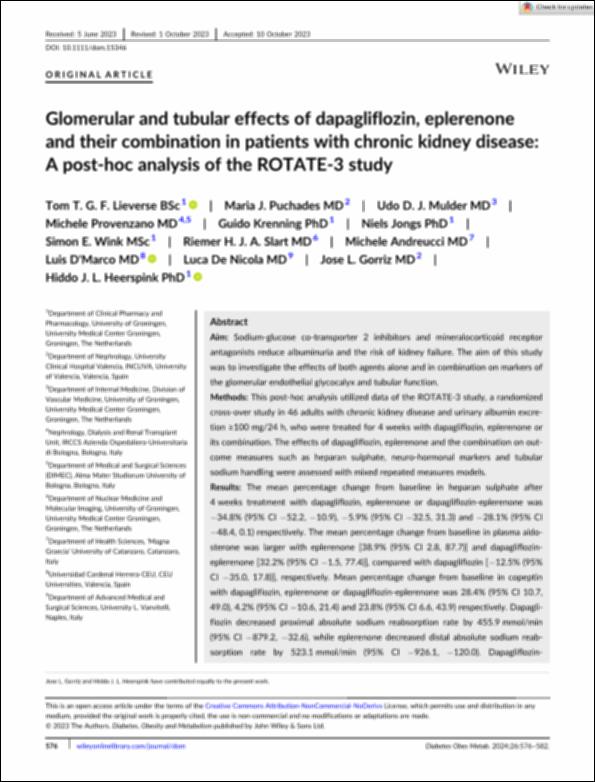Please use this identifier to cite or link to this item:
http://hdl.handle.net/10637/16173Glomerular and tubular effects of Dapagliflozin, Eplerenone and their combination in patients with Chronic Kidney Disease: a post-hoc analysis of the ROTATE-3 study
| Title: | Glomerular and tubular effects of Dapagliflozin, Eplerenone and their combination in patients with Chronic Kidney Disease: a post-hoc analysis of the ROTATE-3 study |
| Authors : | Lieverse, Tom T. G. F. Puchades, María Jesús Mulder, Udo D. J. Provenzano, Michele Krenning, Guido Jongs, Niels Wink, Simon E. Slart, Riemer H. J. A. Andreucci, Michele D'Marco Gascón, Luis Gerardo De Nicola, Luca Górriz, José Luis Heerspink, Hiddo J. L. |
| Keywords: | Dapagliflozina; Dapagliflozin; Eplerenona; Eplerenone; Albuminuria; Diseases; Enfermedad; Urinary system; Sistema urinario; Medical treatment; Tratamiento médico; Drugs; Medicamento |
| Publisher: | John Wiley & Sons |
| Citation: | Lieverse, T.T.G.F., Puchades, M.J., Mulder, U.D.J., Provenzano, M., Krenning, G., Jongs, N., Wink, S.E., Slart, R.H.J.A., Andreucci, M., D'Marco, L., De Nicola, L., Gorriz, J.L. & Heerspink, H.J.L. (2024). Glomerular and tubular effects of Dapagliflozin, Eplerenone and their combination in patients with Chronic Kidney Disease: a post-hoc analysis of the ROTATE-3 study. Diabetes, Obesity & Metabolism, vol. 26, i. 2 (feb.), pp. 576–582. DOI: https://doi.org/10.1111/dom.15346 |
| Abstract: | Aim: Sodium-glucose co-transporter 2 inhibitors and mineralocorticoid receptor antagonists reduce albuminuria and the risk of kidney failure. The aim of this study was to investigate the effects of both agents alone and in combination on markers of the glomerular endothelial glycocalyx and tubular function. Methods: This post-hoc analysis utilized data of the ROTATE-3 study, a randomized cross-over study in 46 adults with chronic kidney disease and urinary albumin excretion ≥100 mg/24 h, who were treated for 4 weeks with dapagliflozin, eplerenone or its combination. The effects of dapagliflozin, eplerenone and the combination on outcome measures such as heparan sulphate, neuro-hormonal markers and tubular sodium handling were assessed with mixed repeated measures models. Results: The mean percentage change from baseline in heparan sulphate after 4 weeks treatment with dapagliflozin, eplerenone or dapagliflozin-eplerenone was -34.8% (95% CI -52.2, -10.9), -5.9% (95% CI -32.5, 31.3) and -28.1% (95% CI -48.4, 0.1) respectively. The mean percentage change from baseline in plasma aldosterone was larger with eplerenone [38.9% (95% CI 2.8, 87.7)] and dapagliflozin-eplerenone [32.2% (95% CI -1.5, 77.4)], compared with dapagliflozin [-12.5% (95% CI -35.0, 17.8)], respectively. Mean percentage change from baseline in copeptin with dapagliflozin, eplerenone or dapagliflozin-eplerenone was 28.4% (95% CI 10.7, 49.0), 4.2% (95% CI -10.6, 21.4) and 23.8% (95% CI 6.6, 43.9) respectively. Dapagliflozin decreased proximal absolute sodium reabsorption rate by 455.9 mmol/min (95% CI -879.2, -32.6), while eplerenone decreased distal absolute sodium reabsorption rate by 523.1 mmol/min (95% CI -926.1, -120.0). Dapagliflozin-eplerenone decreased proximal absolute sodium reabsorption [-971.0 mmol/min (95% CI -1411.0, -531.0)], but did not affect distal absolute sodium reabsorption [-9.2 mmol/min (95% CI -402.0, 383.6)]. Conclusions: Dapagliflozin and eplerenone exert different effects on markers of glomerular and tubular function supporting the hypothesis that different mechanistic pathways may account for their kidney protective effects. |
| URI: | http://hdl.handle.net/10637/16173 |
| Rights : | http://creativecommons.org/licenses/by-nc-nd/4.0/deed.es Open Access |
| ISSN: | 1462-8902 1463-1326 (Electrónico) |
| Issue Date: | Feb-2024 |
| Center : | Universidad Cardenal Herrera-CEU |
| Appears in Collections: | Dpto. Medicina y Cirugía |
Items in DSpace are protected by copyright, with all rights reserved, unless otherwise indicated.


